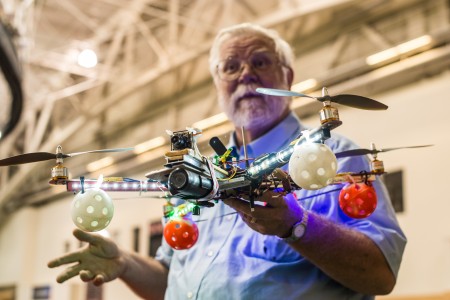The Rosenfield Program of Public Affairs, International Relations and Human Rights and the Henry W. Luce Program in Nations and the Global Environment co-hosted the Drone Symposium from Tuesday, Sept. 9 to Thursday, Sept. 11. The symposium featured speakers with expertise in this field, such as Heather Hayes, assistant professor and chair of the Department of Rhetoric Studies at Whitman College and Pulitzer Prize-winning journalist Pir Zubair Shah.

Photo by John Brady
A wide array of speakers delivered lectures on subjects ranging from their opinion on drone strikes amongst Pakistani tribes to the methods of drone design. These lectures were followed by engaged discussion and questioning from the audience members.
Hayes began the symposium with her speech at noon on Tuesday, entitled “The Buzzing of the Drones: Circulating Violence from Waziristan to Washington.”
Hayes summarized the history of weaponized drone use by the United States and argued that there are current problems with the way the government handles the transparency and control of its weaponized drone programs. She highlighted the discreet bolstering of the military and CIA’s drone programs to what she considered to be disturbing levels.
“We normalize state violence against individual beings, not against armies and not against states, and I argue that is a discursive change,” Hayes said. “[As] a result, certain standards of reasonability gets renormalized.”
Hayes continued her speech with information regarding the way that the Bush and Obama administrations have gradually but consistently increased drone operations since the early 2000s.
She identified the killing of Anwar Al-Awlaki as an example of the problems with drone use in military activity. Despite having dual U.S. and Yemen citizenship, Al-Awlaki was suspected of engaging in terrorist activities, and his death was cited as an example of renormalizing standards of military conduct, namely, that countries cannot kill their citizens without trial. She also noted the fatal strike against Al-Awlaki’s 16-year-old son, who was targeted independently of his father.
Hayes argued that the prevalence of these drone strikes is extremely alarming, partly due to the secrecy surrounding the entire issue as the result of extensive classification of the programs and partly as the result of the freedom the CIA has to carry out drone strikes.
“The Joint Chiefs keep saying, ‘Could we maybe have a say in this? The Department of Defense maybe should say something about the drone program,’ and the [Obama] administration keeps saying, ‘No, no, it needs to stay in the purview of the CIA,” Hayes said.
After her speech, Hayes was asked which policy changes she would like to see made in the future. Hayes stated that increased transparency around the strike coupled with changes to move control of the programs away from the CIA and into the hands of the Department of Defense would produce positive results.
In the following event on Tuesday afternoon, Shah moved the focus away from America to the history, politics and success of drone strikes in Pakistan. As a native to South Waziristan, one of the areas of Pakistan most targeted by drone strikes, Shah discussed how drone strikes in Pakistan became a valid option for the United States.
Shah stated that the complex nature of Pakistani-American relations allows the United States to use drones to strike targets within Pakistan’s western region, the Federally Administered Tribal Area, where the Pakistani government considers such strikes as also in their interest. Shah emphasized that drone strikes, because of their precision, are popular with the locals in this area compared to other alternatives, such as widespread destruction at the hands of Pakistan’s military forces.

Photo by Sydney Steinle
However, Shah expressed pessimism in regards to the future of the program. He listed paranoia on the part of the Pakistani government, Pakistani nuclear proliferation and U.S. neutrality concerning the Afghanistan-Pakistan skirmishes as causes of worsening relations.
“Pakistan is emerging as one of the biggest anti-American countries,” Shah said.
After Hayes and Shah’s speeches, four other Drone Symposium events covered outlying issues related to drones in greater depth.
On Wednesday, Micah Zenko, the Douglas Dillon Fellow in the Center for Preventive Action at the Council on Foreign Relations, spoke on limiting the proliferation of weaponized drones. Medea Benjamin, a cofounder of Global Exchange and CODEPINK: Women for Peace, followed Zenko’s presentation with one that elaborated on the negative aspects of military drones.
On Thursday, Kevin Price, executive vice president of applied research and technology development at RoboFlight, discussed the technology and applications of drones in agriculture. For the final event, Thomas Kaminski, chair of the Madison Section of Electrical Engineers, delivered “How to Build a Drone—Lessons for Students and Researchers.”
Students are encouraged to reach out to Rosenfield Program Director Sarah Purcell to learn more about drone usage and any of the speakers or their research.




























































